ProActive User Group
and
Grid Plugtests
October 18-20th 2004
Authors: OASIS Team and ETSI
1. Overall Objectives
ETSI and INRIA organised a three-day event, which started on October
18th 2004. The objective was to learn, through the ProActive user
experience and through open discussion, about the future features
needed for the Grid middleware as well as to get important feedback on
the deployment and interoperability of Grid applications on various
Grid platforms.
The event consisted of three different happenings. On the first day,
talks were given regarding the use of ProActive, from introduction of
the middleware, to descriptions of its use in the industry, and it's
current research status. The second day was dedicated to a contest
between 6 teams, where the aim was to find the number of solutions to
the N-queens problem, N being as big as possible, in a limited amount
of time. The last day allowed the final discussions and prizes where
distributed to the winners.
This event was organised under the supervision
of UNSA and I3S CNRS, and was sponsored by IBM, SUN and
ObjectWeb.
2. ProActive & User Group
On the three days, the event drew 80 participants, from 10 different
countries : France, Chile, USA, England, Holland, Switzerland, Spain,
Italy, Japan and Korea. All these people met to share their views of
ProActive, the Grid middleware developped in the OASIS team, INRIA.
2.1 ProActive
ProActive is an LGPL Java library for parallel, distributed, and
concurrent computing, also featuring mobility and security in a uniform
framework. With a reduced set of simple primitives, ProActive provides
a comprehensive API allowing to simplify the programming of
applications that are distributed on Local Area Network (LAN), on
clusters of workstations, or on Internet Grids.
The deployment descriptors provide a mean to abstract from the source
code of the application any reference to software or hardware
configuration. It also provides an integrated mechanism to specify
external processes that must be launched and the way to
do it. The goal is to be able to deploy an application anywhere without
having to change the source code, all the necessary information being
stored in an XML descriptor file.
Since programming the Grid cannot be achieved at a low-level of
abstraction, ProActive is provided with a programming model. The
complexity that arises from scale, heterogeneity, and dynamicity cannot
be tackled with message-level primitives. As such, development of new
Grid programming models has to rely on higher-level of abstraction than
the current usage. These programming models are based on the component
technology.
ProActive talks were held on the first day. In the morning, the overall
frame the middleware allows was presented, with talks underlining it's
main aspects. On the afternoon session, users were invited to speak
about their use of the middleware. During the evening, future work was
presented, and a panel of experts was invited to talk about actual
problems in the Grid domain.
2.2 ProActive technology presentations:
On Monday morning, an overview of what ProActive has to offer was
given. After a welcome speech, a first session covered the basic
programming features, and a second session went into more detail into
composing and deploying applications using ProActive.
9:15 “Welcome”, Karl-Heinz Rosenbrock, ETSI DG and P. R. Guillemin,
Session 1: "Basic Programming Features" 9.30-11.00
9.30 "ProActive Overview", D. Caromel, UNSA
ProActive aims at providing a complete solution for the Grid:
- programming,
- wrapping,
- composing,
- deploying.
Based on an Active Object model, asynchronous methods calls with first
class futures is at the root of the programming model. Wait-By-
Necessity enforces that futures are implicit, and can be passed as
parameter and results between distributed machines. The programming
model enjoys a strong property of determinism. Finally, put together
with features to be presented in next talks, the 4 key elements:
- asynchrony,
- wait-by-necessity,
- groups,
- components,
should be the essence of a promissing Grid alchemy.
10.00 "Group Communications, and OO SPMD", L.Baduel, UNSA
The group communication mechanism of ProActive efficiently achieves
asynchronous remote invocation for a group of local or remote object,
with automatic gathering of reply. Given a Java class, one can initiate
groups communication using the standard public methods of the class
together with the classical dot notation; in that way, group
communications remains typed.
The group communication mechanism, joint to a small sized API, allows
the programmer to build Object-Oriented SPMD applications, using data
flow synchronization.
10.30 "Mobility", F.Huet, UNSA
ProActive provides mechanism to perform weak migration of any
serializable active object. The basic API consist in a single migrateTo
method. We also provide a high level API to build itineraries that can
be followed by mobile objects to perform various tasks. In order to
maintain communications, we use two schemes. The first one relies on
forwarders left on each site visited by an agent. The second uses a
centralized server. A thirs one, using both forwarding and a server, is
currently under development.
Session 2: "Composing and deploying" 11.30-13.00
11.30 "Components and Legacy Code", M. Morel, INRIA
The aim of this presentation was to show the relevance of component
based programming in the context of Grid computing. ProActive
components benefit from all standard features of the ProActive library,
and future works will focus on legacy code wrapping, automatic data
redistribution between components and dynamic optimizations.
12.00 "ProActive Grid Deployment and GUI", Romain Quilici, UNSA
This talk covered ProActive's deployment infrastructure, and presented
also ProActive's GUI that provides monitoring and control over deployed
Active Objects. In the context of the GRID, where main concerns include
scalability(large number of machines), heterogeneous resources (OS,
security, model,...) ProActive provides a flexible and scalable
deployment infrastructure based on XML files that provides deployment
on various model of Grid. Indeed ProActive is interfaced with almost
all Grid protocols: SSH, GSISSH, GLOBUS, LSF, PBS, SGE, PRUN, OAR, RSH,
RLOGIN(for Desktop Grid)and also allows combinations of those
protocols. Hence we were able using such features to build an
heterogeneous Grid all over the world , and to use that Grid for the
plugtest contest. ProActive provides also a GUI called IC2D to
monitor, visualize and
control deployed Active Objects, it offers usefull graphical and
textual informations, about the AO's state and allows control such as
migration, termination of the JVMs, Nodes, AOs.
12.30 "Security", A.Contes, INRIA
As ProActive applications could be transparently deployed in many ways,
security related-code should not be tied to source code, but rather to
deployment files. The security model involves hierarchical domains,
dynamic policy negotiation, extensible security policies and deals with
activity migration. As a perspective, we want the security model to
interact with all new ProActive features like components and fault
tolerance mechanism.
2.3 User presentations:
After lunch, some people were offered the opportunity to show how
ProActive can be used to its full potential. The talks showed various
applications, and stressed the versatility of ProActive, which is
capable of providing its services to many different applications,
tahnks to its generic programming model.
14.30 "Distributed agent based simulations with ProActive", Luc
Girardin, Swiss Federal Institute of Technology (ETH) and Macrofocus
Zurich, Switzerland
We are interested in understanding the role played by macro-historical
processes in the emergence of political violence, such as
state-formation, nationalism, and democratization. To trace such
transformations, we rely on a agent-based modeling approach and use a
Java library, RePast, specifically targeted at this type of
simulations. To speed up the computation of our simulations, we explain
how RePast was extended to support distributed simulation runs using
ProActive, and discuss how a more elaborate parallelization scheme can
achieved through a double-buffering technique. ProActive has enabled us
to not just improve our simulations from quantitative point of view,
but also qualitatively as it let us get results almost interactively
instead of having to wait overnight.
15.00 "ProActive based Architecture and Application for the management
of Electrical Grids", E.Zimeo. RCOST, Italy
The talk
discusses the adoption of the ProActive middleware for the
definition of a component in a distributed Web-based architecture for
the security analysis of electrical Grids. The architecture is
characterized by a network of sensors for acquiring data from the
components of an electrical network, a computational engine based on
ProActive for processing data coming from the sensors and a data base
for storing the results of the computation, used for performing
statistical analyses. The computational engine is able to execute a
concurrent algorithm for solving power flow equations for each
possible contingency (faulty) in the electrical network. The
algorithm is transparently executed by using a hierarchical master
slave model mapped on a hierarchical network of computational
resources through the distributed implementation of the hierarchical
master/slave design pattern. The allocation of each slave task to a
different computational resource belonging to a set of heterogeneous
resources is improved and automated through the adoption of a broker
provided by HiMM (Hierarchical Metacomputing Middleware), a
middleware for Grid computing developed at the University of Sannio,
on top of which a specific implementation of ProActive was carried
out. By using a variant of the time minimisation algorithm proposed
by Buyya, the broker is able to select in a network of heterogeneous
computers the ones that ensure the termination of the security
analysis in a prefixed time, specified by the user as desired QoS for
the computation. Moreover, the talk illustrates future enhancements
of the computational engine through the adoption of ProActive groups
and their enhancements. Groups make easier and more efficient the
implementation of the hierarchical master/slave pattern on a
hierarchical physical architecture. However, to achieve this goal,
ProActive groups have to be extended both for the semantics and the
implementation. The semantics could be extended by introducing the
possibility to specify (at creation time or later) the policy adopted
to distribute the invocation of a method to the internal replicas. On
the other hand, the efficiency could be improved by implementing the
groups on reliable multicast protocols. The availability of such kind
of groups will make possible an effective and efficient framework
based on ProActive for hierarchical master/slave computing on the
Internet.
15.30 "Computational Electromagnetism on the Grid: a ProActive
time domain finite volume solver for 3D Maxwell Equations",
S. Lanteri, CERMICS/INRIA/UNSA
We discuss the application of distributed objet oriented programming in
Java to the development of a grid aware tool for the numerical
simulation of large-scale, 3D, electromagnetic wave propagation
problems. The time domain Maxwell equations are solved using a finite
volume solver on unstructured tetrahedral meshes. The ProActive library
greatly facilitates the development of a distributed object oriented
SPMD version of the solver. Preliminary performance results are
presented for calculations that have been performed on a cluster of
PCs.
16.00 "Distributed BLAST with
ProActive" Santosh Anand, Institute of Signaling,
Developmental Biology and Cancer, Nice
Protein and DNA sequence comparison is one of the most important tool
of molecular biologists, but sequence databases are growing at an
exponential rate, and sequence comparison is becoming increasingly
computationally intensive. We propose to develop a GRID-enabled
parallel blast, GeB, which is implemented on the ProActive platform.
With some very good group communication facilities provided by
ProActive, we achieved good speedup and scaling results (up to 39
processors). Encouraged by this, we next move to work on a better
load-balancing facility which might give a very good speedup for our
GeB.
17.00 "Evaluation of ProActive and other middlewares for a Data
Driven
Environement for Multiphysics Application" John G. Michopoulos,
U.S. Naval Research Laboratory, Washington DC, USA
The
recently experienced enormous progress and proliferation of
distributed computing, has lead to the development of a very large
amount of middleware technologies. The efforts are originating from
groups distributed worldwide and span various areas of interest. The
pluralism of particular architectures and implementations along with
the custom and generalized needs emanating from the need to develop
particular applications, force the idea of a comparative study of the
various middleware platforms.
In
an effort to select a middleware platform for developing an
architecture and an implementation of a data driven environment for
multiphysics applications (DDEMA) we were forced to develop a
comparative strategy of the available technologies and subsequently
apply it for evaluation purposes. According to this strategy we
utilized DDEMA’s design requirements to help us define a two
stages approach. In the first stage a set of knock out
(accept-reject) criteria were developed and applied to all identified
middleware platforms. In the second stage a second set of criteria
were developed and applied to the platforms that survived the first
stage in a manner that allowed assignment of weighted ranking.
This approach enabled the quantitative comparison of
“ProActive” (a platform of main interest because of its maturity) with
other agent middleware platforms. The results clearly demonstrated that
the higher performers were of ProActive, Jade/Leap and Grasshopper.
However, it was established that developer familiarity to a particular
platform can often overtake any other performance metric.
During the breaks, there was a live demo in the hall: "JECS: Steering
and Visualization of 3D numerical simulations on the Grid", Said El
kasmi, S. Lanteri, et al. This proved how ProActive can use two
different machines collaboratively.
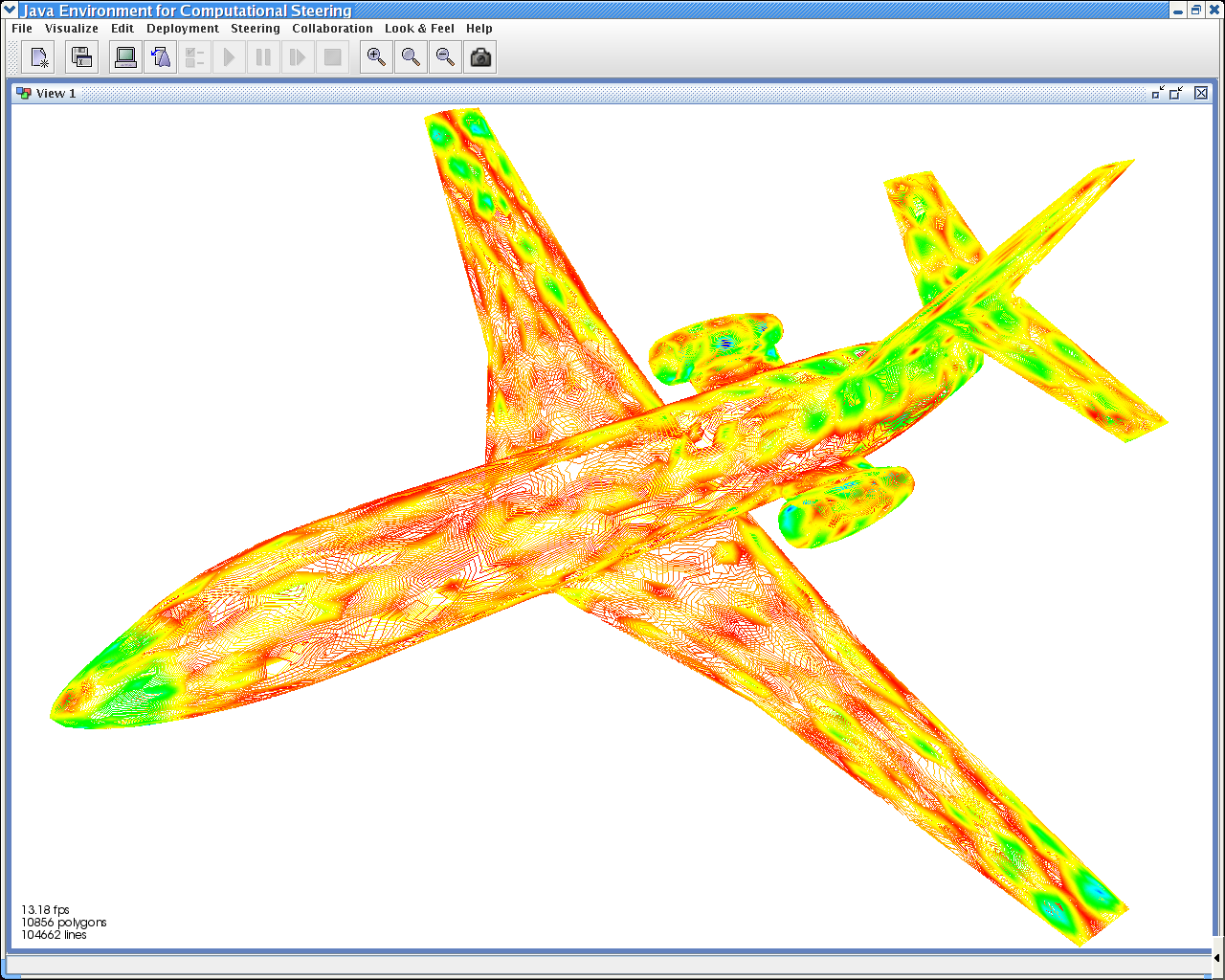
Physics of a Falcon
plane, as shown in the demo
2.4 ProActive perspectives
In the later part of the afternoon, some
work-in-progress was presented. This session was meant to show what
future features are expected to be offered by the middleware, and what
the burning topics are today in the Grid computing field.
17:30 “Web Services, C# .Net interop, HTTP, SSH Tunneling” Virginie
Legrand
ProActive applications separated by firewalls may need to communicate.
The issue is that using RMI communication, more than one port must be
opened on these firewalls. We improved a new communication layer based
on HTTP in order to use only the usual opened port. Users can also
monitor ProActive applications from any web services enabled languages
thanks to the ability to export an active object as a web service.
17:40 “Fault Tolerance” Christian Delbé
Next release of ProActive will include fully-transparent
fault-tolerance feature. Based on a communication-induced checkpointing
mechanism, this feature allow ProActive applications to restart
automatically after the failure of one (or more) of the active objects,
while preserving the work done until this failure. There is no need to
modify nor recompile an application to make it fault tolerant.
This work first targets applications running on a single cluster ; we
are currently designing a global protocol based on this work for large
applications running on the Grid.
17:50 “Peer-To-Peer” Alexandre di Costanzo
The goal of this work is to use sparse CPU cycles from organizations
desktop workstations. First, we are proposing a P2P infrastructure to
create a network of JVMs (computational nodes); this infrastructure is
self-organized and tunable. The second part is to provide a high level
model of P2P programming by an API to solve Branch and X problems.
18:00 “Dynamic Load Balancing of Active Objects” Javier Bustos
The goal of this study is to show the potential of ProActive,
developping a load balancing architecture only using the API of
ProActive. This load balancing is based in two principles: each node
will only know its own load (reduces the network load) and each node
will make its own decisions (avoids the use of a central load balancer,
which is not scalable in practice). These decisions have to follow two
objectives: each machine wants to work all the time and the application
wants to be optimal. For the study of this problem, we divided the
decision in five questions: "How to coordinate the Load Balance?",
"Where to migrate active objects?", "When to initiate the migration of
active objects?", "How many Active Objects should we migrate?" and
"Which active object has to migrate?". Experimentaly we found the
answer for the first two questions and we are studying the third.
18:10 “OSGi” Françoise Baude
The idea is to be able to run ProActive applications as OSGi bundles.
The obvious advantage comes from the fact that the OSGi Alliance
Service Platform (www.osgi.org)
adoption is very large because it enables services for networked
devices (e.g. in industrial or home automation, vehicles, smart phones,
etc). One ProActive application we foresee is a remote management tool
of OSGi services and platforms.
18:20 “Formal Verification and Behavioral Properties” E. Madelaine
We build tools for extracting automatically behavioral models from the
source code of ProActive applications, and use model checking
techniques to prove their temporal properties (dead-lock freedom,
reachability, liveness). This will also lead to techniques for proving
correct the assembly of distributed components.
2.5 Panel: Stateful vs. Stateless Web
Services for
the Grid
The day was concluded by a panel involving experts, answering current
questions on the Grid problems.
18.30 Panel: "Stateful vs. Stateless Web Services for the Grid: how
to get both scalability and interoperability?" Denis Caromel
(UNSA), Tony Kay (SUN Microsystems), Jean-Pierre Prost (IBM EMEA Grid
Computing) , Vladimir Getov (University of Westminster), Marco
Danelutto (University of Pisa), Christophe Ney (ObjectWeb).
During the evening cocktail, we heard many interesting conversations
and took note of many appealling requests from the users :
-
Light weight clients (John Michopoulos)
- Workflow and Files transferts (Eugenio Zimeo)
- Hierarchical Groups (Eugenio Zimeo)
- Kerberos (John Michopoulos)
- Mobility: move away as soon as possible (John Michopoulos)
- Wrapping: reuse and integrate previous work on Wrapping
legacy code
(Vladimir Getov)
- Virtual Nodes: make sure all nodes in a VN are running
(Marco
Aldinucci)
- Information on topology of nodes and virtual nodes (Eugenio
Zimeo)
- You cannot force site to change and must adapt (Robert
Jones)
3. The Grid
To
be able to run experiments on Grid computing during our three day
event, a Grid was built up, with the help of our different partners.
The Grid was deployed on 20 different sites, in 12 different countries.
We gathered a total of 473 machines, bearing 800 processors, totalling
100 GigaFlops (measured with the SciMark 2.0 agent for computing). This
measure was taken using a pure JAVA benchmark. The advantage of JAVA is
it's portability and ease of expression. On the other side, using
native code runs faster, but the portability is lost, and more work has
to be commited to deployment on heterogeneous platforms.
Difficulties encountered for the
Grid setup
Since each site had it's own local configuration, nothing proved simple
in the Grid configuration, as OS, JVM, schedulers, and protocols
differed from one site to the other. But this was the work of people of
the OASIS team, in particular Romain Quilici and Arnaud Contes, who
prepared this Grid for the contest and the Plugtests. After a lot of
hard work to set all the configuration files and accounts right, the
deployment was made very simple and transparent to the Plugtests
application developers, who had all the details hidden by the ProActive
layer.
Installation: We had to install ProActive on all sites. Some of
these were using file systems (NFS) that allowed to install only once
the software, and on others the instalation procedure had to be
repeated on every machine. Since JAVA is the underlying programming
language, it also had to be installed when it was missing, which meant
finding the correct JAVA version depending on the operating system. Job
schedulers used on different sites and that were not yet supported by
ProActive were also implemented : PBS, SGE, OAR. Finally, acces
configuration for all teams had to be performed on each site, which was
found to be a very long and arduous task, due to the Grid's large size.
Security policy: Each site had its own security policy, in which
we define four levels of friendliness
- friendly : sites allowed all incoming/outgoing connections
from/to machines on the ETSI Plugtests network.
- semi-friendly : sites allowed a range of ports to be open, in
which case http was used as a communication protocol to gain acces to
the machines.
- Semi-restrictive : sites allowed only ssh communication, and we
had to implement and use ssh/RMI-tunneling to deploy jobs.
- Resctrictive : sites had a public IP address for the front-end,
and private Ips for the backend nodes. Users were constrained to
implement hierarchical deployment in their application. These sites
were not very much used.
Some other problems were encountered, and forced other features to be
added to ProActive. For example, the proactive.useIPaddress
property was implemented to cope with sites that did not host a DNS,
and proactive.hostname which dealt with machines that had two
network interfaces.
The map which follows shows the location of the different sites. It
shows how we reached a worldwide dissemination, with sites in
Australia, Europe, North and South America, and India. A table is added
to give technical details of every site, and sketch the computing power
available and the differences of specifications.
ProActive
Plugtests Grid : worldwide location of sites
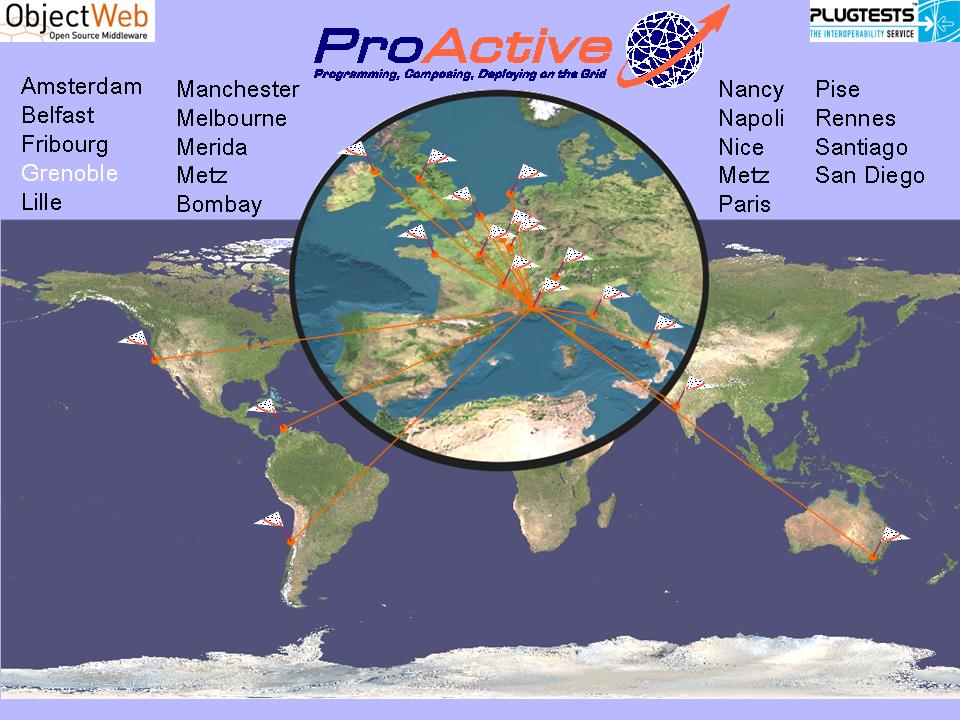
ProActive Plugtests Grid :
description
of sites
|
Location
|
Machines
|
CPU (Ghz)
|
Processors
|
OS
|
Scheduler
|
JVM
|
Standard deployment
|
|
Imag
|
70
|
0.9
|
2
|
Linux
|
OAR
|
Sun
|
|
Irisa
|
32
|
?
|
2
|
Apple
|
Web
|
Sun
|
|
Irisa
|
64
|
2.4
|
2
|
Linux
|
Web
|
Sun
|
|
LRI
|
50
|
2.2
|
1
|
Linux
|
ssh
|
Sun
|
|
Inria
|
16
|
2
|
2
|
Linux
|
LSF
|
Sun
|
|
Inria
|
19
|
0.93
|
2
|
Linux
|
LSF
|
Sun
|
|
San Diego
|
32
|
1.6
|
2
|
Linux x86_64
|
ssh
|
1.5
|
|
ESSI
|
17
|
2.26
|
1
|
Linux
|
ssh
|
Sun
|
|
ESSI
|
12
|
2.8
|
1
|
Linux
|
ssh
|
Sun
|
|
Man-chester
|
20
|
3
|
2
|
Linux
|
Globus
|
Sun
|
|
Amster-dam
|
20
|
1 (P3)
|
2
|
Linux
|
prun
|
Sun
|
|
Chile
|
11
|
1.5(P4)
|
1
|
Linux
|
ssh
|
Sun
|
|
Belfast
|
2
|
1.5
|
1
|
Linux
|
ssh
|
Sun
|
|
Supelec
|
8
|
2.4
|
1
|
Linux
|
ssh
|
Sun
|
|
LIFL
|
4
|
1.7|1.9|3|3
|
1
|
Linux
|
ssh
|
Sun
|
|
ISTI
|
4
|
1.8|2|2|2
|
1
|
Linux
|
ssh
|
Sun
|
|
Bull
|
2
|
1.3
|
16|16
|
Linux ia 64
|
ssh
|
Bea
|
|
EIF
|
25
|
0.5
|
1
|
Solaris9
|
ssh
|
Sun
|
|
Loria
|
6
|
1.5
|
1
|
Linux
|
ssh
|
Sun
|
|
Loria
|
2
|
0.7
|
32|24
|
SGIIrix
|
ssh
|
Sgi
|
|
Napoli
|
5
|
2.4
|
2
|
Windows
|
ssh
|
Sun
|
Hierarchical deployment
|
|
Mel-bourne
|
13
|
2.4
|
1
|
Linux
|
PBS
|
Sun
|
|
Napoli
|
7
|
2.2
|
1
|
Linux
|
SGE
|
Sun
|
|
Pise
|
20
|
0.8
|
1
|
Linux
|
no
|
Sun
|
The table above lists the technical details of the different sites. The
hierarchical deployment had to be used when the
backend machines were not directly accessible. Full deployment was
achieved by using first an xml file to deploy on the frontend, which in
turn reads another xml file to create JVMs on backend machines.
4. The Contest
The second day hosted two different activities. A contest, involving
finding solutions to the N-Queens problem was organised, and Hands-on
tutorials were also provided.
The Hands-on session was dedicated to testing the deployment of
ProActive applications on various Grids, using various standard
protocols (ssh, Globus, Web Services, Jini, LSF, PBS, rsh, rlogin,
etc.). Tutorials
were also on the schedule, and some members of he ProActive development
team offered their help to newcomers with the guided tour. Theses
activities were set in the same time span as the contest, which was
meant to get people thinking on the same problem, with the cleverest
implementation rewarded.
4.1 The N-Queen Challenge
A contest was
organised around solving an embarassingly parallel problem. Using
ProActive, for the largest chessboard of dimension N, count the number
of solutions for placing N non-threatening queens. The world record is
for N=24, having 227,514,171,973,736 solutions. All
users were asked to use ProActive as their middleware, and could
freely use the power of the 800+ processors which were dispatched
around the world.
4.2 The teams
The teams were composed of the following people:
AlgoBAR :
Philippe SIGAUD philou@sigaud.fr
Philippe HENRI philippe.henri@TISCALI.FR
;
henri@essi.fr
DCC.UCHILE.CL : Dpto. Cs. de la Computación, Universidad
de Chile
Mario Leyton mleyton@dcc.uchile.cl
Antonio Cansado
Luis Mateu
INRIA :
Vincent CAVE vincent.cave@sophia.inria.fr
Guillaume CHAZARAIN guillaume.chazarain@sophia.inria.fr
Alexandre Di Constanzo alexandre.di_costanzo@sophia.inria.fr
Bernard Serpette serpette@lo.inria.fr
NTU :
Arping, Dr. Yuh-Pyng Shieh arping@turing.csie.ntu.edu.tw
TOURNANT :
Christophe TOURNANT Christophe.TOURNANT@cote-azur.cci.fr
University of Southern California :
Yu Chen cheny@usc.edu
Eugene Song
Sébastien Flament flament@obs-nice.fr
Laurent Devallonné
4.3 The rules
This event was strictly an engineering event, not a conference, nor a
workshop. As such, an active participation was
requested from the companies/organisations which had to write their own
implementation of the N-Queens algorithm, and eventually modify
existing xml deployment to adapt to their strategy.
The overall general results are to be fed back into the
standards process.
There was no compulsory programming language, but all
teams used JAVA to write their code, expect from the Arping team which
hid some native routines inside a JAVA wrapper. This scheme led to a
faster algorithm, but lost JAVA's portability. The sites had to be
updated with this native code, which would be hard to do on a bigger
scale. On the other hand, the all-JAVA approach allowed for transparent
migration of code to distant nodes, with no manual code exportation.
The criterion for deciding the winners were based on
- the greatest number of solutions found
- the biggest number of processors used
- the fastest algorithm.
4.4 The timings
Every team was given enough time to complete several
runs of their algorithm. In the following table, the results are shown
in a synthetic way : for every N queens, the number of solutions found
by the team is displayed.
|
ARPING
|
|
TOURNANT
|
|
AlgoBAR
|
|
|
18
|
666090624
|
20
|
39029188884
|
21
|
314666222712
|
|
18
|
666090624
|
<21
|
3933929944
|
19
|
4968057848
|
|
18
|
666090624
|
|
|
19
|
4968057848
|
|
19
|
4968057848
|
|
|
|
|
|
20
|
39029188884
|
|
|
|
|
|
|
|
|
|
|
|
|
Total
|
45 995 518 604
|
|
42 963 118 828
|
|
324 602 338 408
|
|
UCHILE
|
|
USC
|
|
INRIA
|
|
|
|
|
15
|
2279184
|
21
|
39029188884
|
|
18
|
666090624
|
18
|
666090624
|
20
|
314666222712
|
|
4 x 20
|
156116755536
|
19
|
4968057848
|
|
|
|
2 x 21
|
629332445424
|
|
|
|
|
|
2 x 19
|
9936115696
|
|
|
|
|
|
|
|
|
|
|
|
|
Total
|
796 051 407 280
|
|
5 636 427 656
|
|
353 695 411 596
|
4.5 The results
The chilian team got ahead of the other 5 participants. They found the
number of solutions for 18 queens, 19 queens twice, 20 queens 4 times
and 21 queens once, in an hour. They were the best when considering
- the number of solutions found in one hour (800 billion),
- the number of nodes used (560),
- and the speed of the algorithm (21 queens in 24'38”).
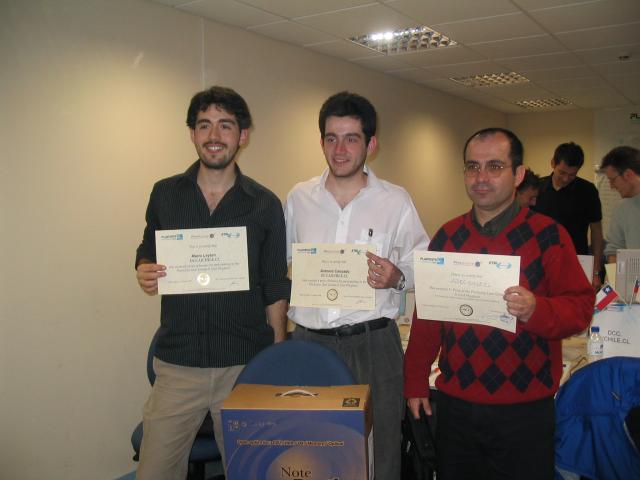
The winners, Mario Leyton, Antonio Cansado, and Luis Mateu from Chile.
5. Conclusion and Future Events
The PlugTest, coorganised by INRIA and ETSI, pleased
all the participants. It was an event both useful for the users, who
received help from the ProActive team, and the OASIS team, who received
feedback from the users. We were forced to add functionnalities to the
middleware to be ready and effective for the PlugTest, and have a
stable system. We had to develop certain aspects that had been left
out, due to time restrictions and priorities, that were in fact of
primary importance. We are also very satisfied with the results
obtained during the N-queens contest, which showed that applications
could take advantage of the Grid in a simple way. Another happy
discovery was the number of different scientific domains which could
use our middleware in their applications – this is a direct effect of
the generic programming model used inside, which can be reused for
biology, physics and evolving phenomenons.
We did have trouble setting up the Grid to work, as
some protocols had to be implemented, so that the clusters could be
reached, even with their restrictive security policies, different OSs
and local configuration. This difficult tuning proves that the Grid is
not yet ready for Plug & Play, but once this configuration was
achieved, the work for the users was simple. Indeed, the deployment on
the different sites was not a source of problems, which is an indicator
of how ProActive is fit for usage, as users were not bothered by system
configuration, and could instead focus on the internals of their
application.
Pressed by the general demand, we will be organising
another PlugTest on October 17-21th 2005. The event is
planned to be larger, on all scales: we expect more people (more than
150), a longer time span (5 days), a larger Grid, the use of other
middleware, and an even wider panel of domains. This futur event will
be coorganised with several European Projets. The application used for
the contest and interoperability PlugTest is not yet fixed, but we have
been thinking about a travel sales man problem, which needs many more
communications, and will be even more interesting and demanding to
supervise.
Thanks to all of the participants of
the 1st Grid
Plugtest edition
Isabelle Attali
Denis Caromel
Thierry Priol
Yvon JEGOU
franck cappello
Vincent Neri
Jean-Louis Roch
Eric Ragusi
Daniel Terrer
Francis Montagnac
Marc VESIN
Franck Yampolsky
David Geldreich
Sebastien GEORGET
Nicolas Niclausse
Regis Daubin
Antoine Zogia
Alain Giulieri
Jean-Louis Faraut
Christophe Coroyer
Michel Riveill
Le Rouzic
Stephane Martin
Tony Reix
Simon Derr
Jean-Claude Paul
Jens Gustedt
Xavier Cavin
Olivier Demengeon
Benjamin DEXHEIMER
Stéphane Vialle
Patrick Mercier
Melab Nouredine
El-Ghazali Talbi |
Sebastien CAHON
Henri Bal
Kees Verstoep
Stephen Pickles
Matt Ford
Mike 'Mike' Jones
Ron Perrott
Tony McHale
Philip Preston
Pierre Kuonen
Jean-François Roche
Ranieri Baraglia
Giancarlo Bartoli
Domenico Laforenza
Marco Danelutto
Pietro Vitale
Marco Vanneschi
Marco Aldinucci
Eugenio Zimeo
Nadia Ranaldo
Luis Mateu
Jose Piquer
Andrew A.
Chien
Troy Chuang
Rajkumar Buyya
csyeo
Leandro León
Gilberto Diaz
José Aguilar
Patrick Guillemin
Philippe Cousin
The OASIS team
Romain Quilici
Laurent Devallonné
Maria-Luisa Parlatano |
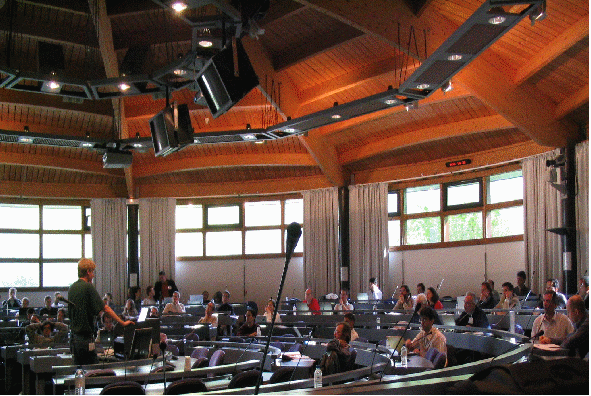
The theater
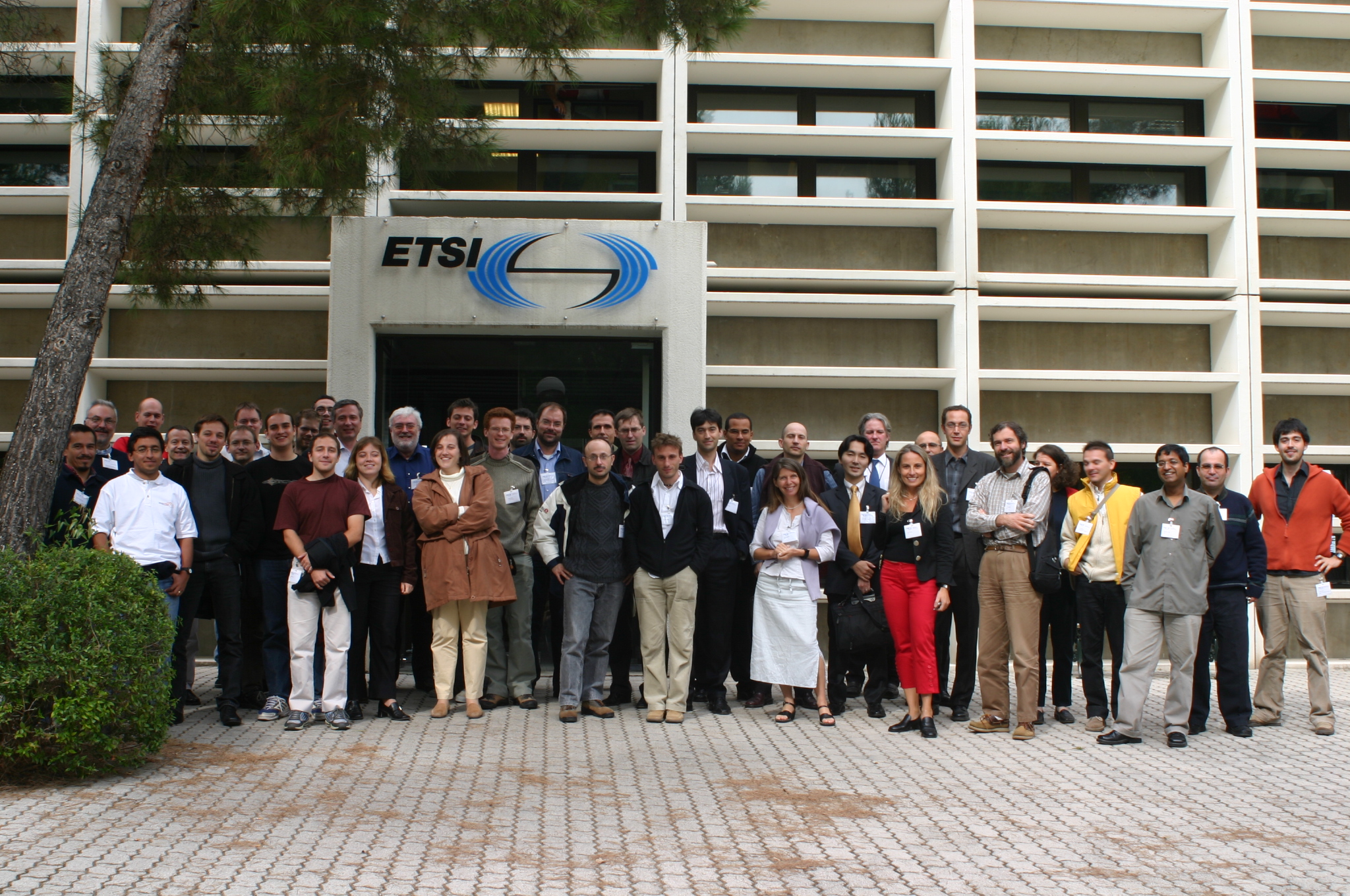
Group photo

The ProActive Demo
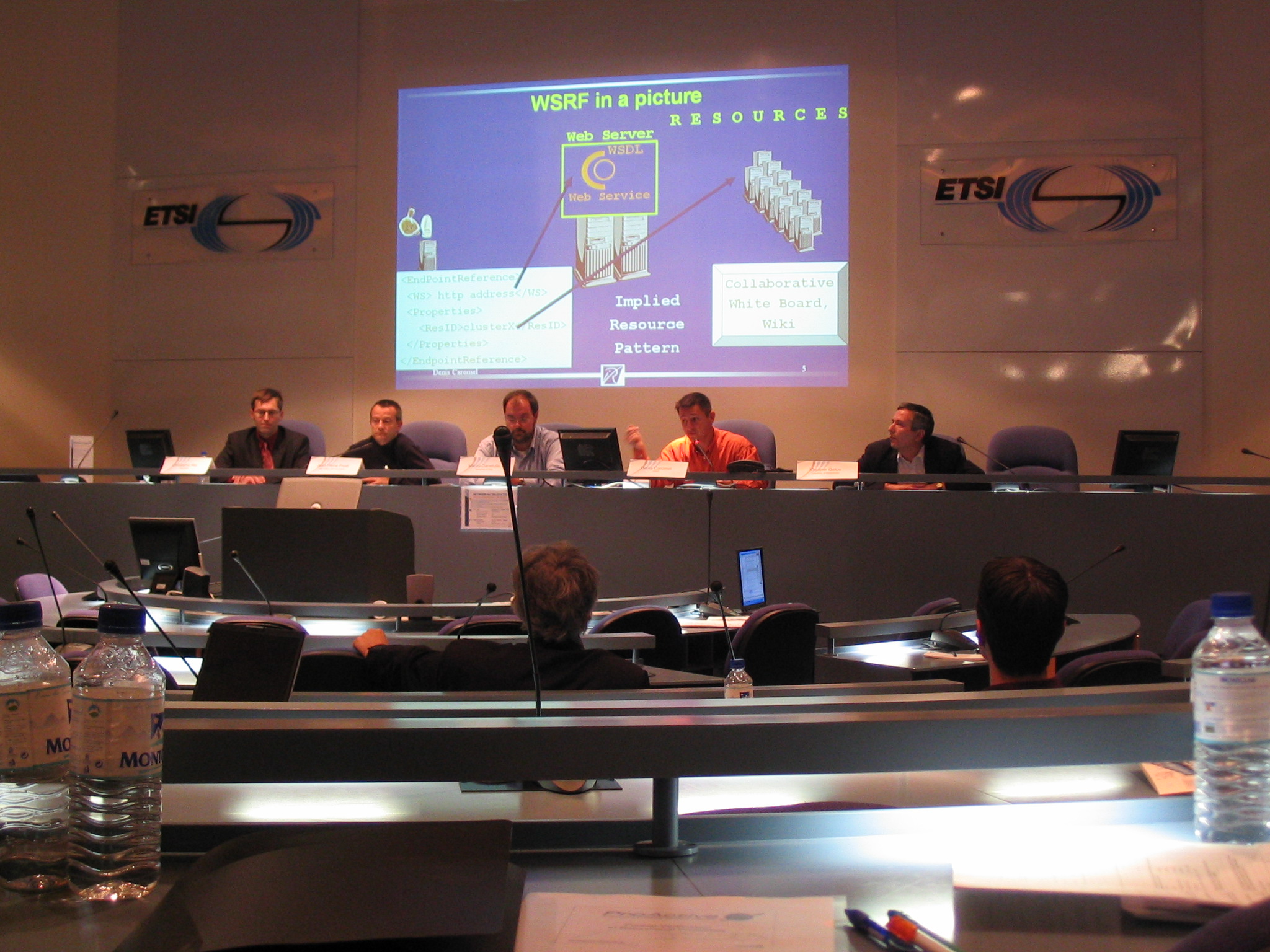
The panel of experts






